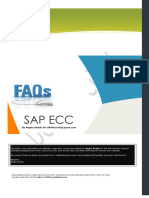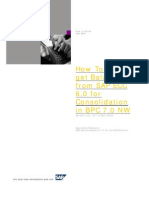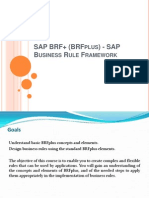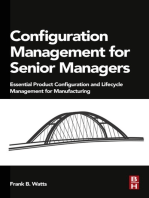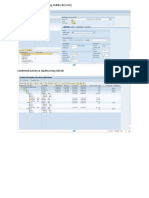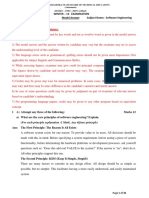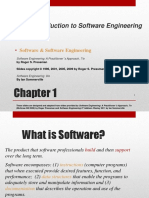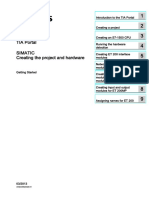Professional Documents
Culture Documents
Course Material - Blocking & Deletion 4 - Data Controller Rule Framework - Features Supporting GDPR in SAP S4HANA Cloud - Public - SAP
Uploaded by
Sam DesuzaOriginal Title
Copyright
Available Formats
Share this document
Did you find this document useful?
Is this content inappropriate?
Report this DocumentCopyright:
Available Formats
Course Material - Blocking & Deletion 4 - Data Controller Rule Framework - Features Supporting GDPR in SAP S4HANA Cloud - Public - SAP
Uploaded by
Sam DesuzaCopyright:
Available Formats
Guide for Blocking and Deletion – Data
Controller Rule Framework
SAP S/4HANA Cloud
© 2018 SAP SE or an SAP affiliate company. All rights reserved.
No part of this publication may be reproduced or transmitted in any form
or for any purpose without the express permission of SAP SE or an SAP affiliate company.
SAP and other SAP products and services mentioned herein as well as their respective logos are trademarks or registered trademarks of SAP SE (or an SAP affiliate company) in Germany and other countries. Please see for additional
trademark information and notices. Some software products marketed by SAP SE and its distributors contain proprietary software components of other software vendors.
National product specifications may vary.
These materials are provided by SAP SE or an SAP affiliate company for informational purposes only, without representation or warranty of any kind, and SAP SE or its affiliated companies shall not be liable for errors or omissions with
respect to the materials. The only warranties for SAP SE or SAP affiliate company products and services are those that are set forth in the express warranty statements accompanying such products and services, if any. Nothing herein
should be construed as constituting an additional warranty.
SAP SE or its affiliated companies have no obligation to pursue any course of business outlined in this document or any related presentation, or to develop or release any functionality mentioned therein. This document, or any related
presentation, and SAP SE’s or its affiliated companies’ strategy and possible future developments, products, and/or platform directions and functionality are all subject to change and may be changed by SAP SE or its affiliated companies
at any time for any reason without notice. The information in this document is not a commitment, promise, or legal obligation to deliver any material, code, or functionality. All forward-looking statements are subject to various risks and
uncertainties that could cause actual results to differ materially from expectations. Readers are cautioned not to place undue reliance on these forward-looking statements, which speak only as of their dates, and they should not be relied
upon in making purchasing decisions.
Guide for Blocking and Deletion - Data Controller Rule Framework 1
SAP Services
Published Date 7th May 2018
Version History
Revision Change Date Description
1 May 04th, 2018 Guide for Blocking and Deletion – Data Controller Rule Framework
SAP S/4HANA Cloud - Draft Version
2 May 07th, 2018 Guide for Blocking and Deletion – Data Controller Rule Framework
SAP S/4HANA Cloud - Final Draft Version
Guide for Blocking and Deletion – Data Controller Rule Framework 2
Contents
1 Introduction ...................................................................................................................................................................... 4
Preparation .............................................................................................................................................................. 4
Tools ........................................................................................................................................................................ 6
1.2.1 Create and maintain default audit area for retention rule generation ................................................................. 6
1.2.2 Define time references ........................................................................................................................................ 7
1.2.3 Define purposes ................................................................................................................................................ 11
1.2.4 Maintain data controllers ................................................................................................................................... 13
1.2.5 Create and simulate ILM rules .......................................................................................................................... 15
1.2.6 Activate ILM rules .............................................................................................................................................. 17
Guide for Blocking and Deletion – Data Controller Rule Framework 3
1 Introduction
You use the Data Controller Rule Framework to ensure that personal data can be stored according to applicable legal
requirements and in compliance with general data privacy acts. Any personal data collected or processed is linked to a
predefined purpose. The data controller determines the purposes for which and the manner in which any personal data is
to be processed. Even after the residence periods (which represent the primary purpose for which the personal data was
initially stored) ends, personal data can still be retained for other explicit legal reasons. The reasons include retention
periods prescribed by law, statutes, or contracts. After the end of all retention periods, personal data shall be destroyed.
The Data Controller Rule Framework simplifies the maintenance of these residence periods and retention periods. It
provides the definition of purposes as reasons for storing personal data representing the used business processes and
the involved business objects. The definition of the data controller assigns the line organization attributes, which represent
the data controller in the system. The rule maintenance is based on the data controller and the purposes defined for a
data controller. The data controller and purposes are related to the data in the system as well as to the Information
Lifecycle Management (ILM) objects. The activation of maintained rules creates all the required ILM configuration and
policies for each assigned ILM object according to its individual settings.
A customer key user who is responsible for maintaining retention and residence rules will define these rules during the
initial preparation of the system and also later as and when any adjustment is needed.
Preparation
Data Controller Rule Framework requires following application and roles:
Fiori Application name Business Role required Use
ILM Audit Area SAP_BR_DATA_PRIVACY_SPECIALIST Using this app, you can create new audit areas
and edit existing audit areas.
Data Controller Rule SAP_BR_BPC_EXPERT With this app, you can define the data controller,
Framework assign organization entities and set conditions for
the organization entities
SSCUI - Define data
controller
Data Controller Rule SAP_BR_BPC_EXPERT With this app, you can define a purpose, assign
Framework ILM objects to purpose, and maintain condition
fields. The purpose can be used when defining
SSCUI - Define purpose of
retention rules in SAP ILM or when providing
retention rules
information on personal data.
Data Controller Rule SAP_BR_BPC_EXPERT With this app, you can set the default time
Framework reference and time offset for an ILM object. This
would be used in the rule generation for all ILM
SSCUI - Set time reference
policies.
and time offset
Data Controller Rule SAP_BR_BPC_EXPERT With this app, you can set the default audit area for
Framework the rule generator
SSCUI - Set default audit
area
Manage ILM Business SAP_BR_DATA_PRIVACY_SPECIALIST Using this app, you can create and edit ILM
Rules business rules.
Guide for Blocking and Deletion – Data Controller Rule Framework 4
For the purpose of this guide, it is assumed you will use two organizational entities: Germany (company code 1010) and
US (company code 1710) and two purposes as reasons to store personal data. Both entities process personal data due to
sales of books and sales of tax advisory services. Each purpose requires different retention and residence periods for
these entities. Different sales order types are used to process sales of books (OR) and tax advisory services (L2). Next
you create and activate ILM rules for. The table below summarizes combinations of data controllers and purposes:
Org.entity - Data Purpose Order type Residence Retention
Company Code controller
Books OR 1 day 1 day
Germany [1010] DE_DC
Tax services L2 1 day 2 days
Books OR 1 day 1 days
US [1710] US_DC
Tax services L2 1 day 3 days
Guide for Blocking and Deletion – Data Controller Rule Framework 5
Tools
1.2.1 Create and maintain default audit area for retention rule generation
Logon with the Business Role SAP_BR_DATA_PRIVACY_SPECIALIST.
You will create a new Audit Area which will be used by Business Rule Generator to create retention rules.
If you already have such audit area, you can skip this step.
Open the ILM Audit Area app.
Choose New. On the Audit Area: NEW screen, enter a name for the audit area which starts with Y
or Z, a description, and select the policy category Retention Rules.
Scroll down the list of ILM Objects until you see desired object. Include the object in this Audit
Area by selecting checkbox Object Assignment.
Choose Save.
Guide for Blocking and Deletion – Data Controller Rule Framework 6
1.2.2 Define time references
Logon with the Business Role SAP_BR_BPC_EXPERT.
Open the Manage Your Solution app.
Choose Configure Your Solution.
On the next screen, select:
Application Area: Enterprise Technology
Sub Application Area: Retention Management
Choose Go.
Guide for Blocking and Deletion – Data Controller Rule Framework 7
You will be presented with one configuration option Rule Generator. Choose this line.
To select Set Default Audit Area, choose Configure.
Using search function, choose the default Audit Area for rule generation and save your changes.
Guide for Blocking and Deletion – Data Controller Rule Framework 8
Go back to Configuration Your Solution – Rule Generator screen and choose Configure for Set Time Reference and
Time Offset.
To view the objects that are already available, choose Go. If the object for which you want to set up time reference is
already on the list, select the line and skip next step.
If the object you need is not yet available, choose the + icon on the Define Time Reference screen.
Guide for Blocking and Deletion – Data Controller Rule Framework 9
On the next screen, enter the required information in the fields, for example:
ILM Object: SD_VBAK
Time Reference: LAST_CHANGE_DATE
Time Offset:
Choose Save.
Go back to the Configuration Your Solution – Rule Generator list.
Guide for Blocking and Deletion – Data Controller Rule Framework 10
1.2.3 Define purposes
You will create two new purposes for data processing: sales of books and sales of tax advisory services.
The purpose represents a business process that groups ILM objects that relevant for the process. These ILM objects have
the same residence rules and retention rules. In our guide we will use object SD_VBAK (sales order).
Logon with the Business Role SAP_BR_BPC_EXPERT, choose Configure Your Solution app and
access configuration option Rule Generator. Choose Configure in line Define Purpose of
Retention Rules.
To view the purposes that are already available, choose Go. If the purpose for which you want to set up time reference is
already on the list, select the line instead of creating new purpose.
On the Define Purpose screen, choose the + icon to create the purpose.
Guide for Blocking and Deletion – Data Controller Rule Framework 11
On the next screen, enter the required values in the following fields, for example:
Purpose ID: BOOKS
Purpose Description: Books sales
Choose Save.
Select the newly created purpose from the list. You might need to choose Go to view it.
On the ILM Object Assignment tab, choose Add.
In the Assign ILM Object dialog box, add an ILM object that you want to assign, for example, SD_VBAK.
Choose Save.
Select the newly created object from the ILM Object list.
Choose Add. On the ILM Object Condition Assignment tab, choose the field for Condition, and enter condition values in
the From and To fields. Choose Save and go back to the Configuration User Interfaces list.
You can repeat the steps and create another purpose, e.g. sales of tax advisory services, with the
same condition field (sals order type) but different condition value (order type L2).
Guide for Blocking and Deletion – Data Controller Rule Framework 12
1.2.4 Maintain data controllers
Logon with the Business Role SAP_BR_BPC_EXPERT, choose Configure Your Solution app and
access configuration option Rule Generator. Choose Configure in line Define Data Controller.
You will create two new data controllers for two new entities: DE and US
To view the objects that are already available, choose Go.
On the Define Data Controller screen, choose the + icon to create the object.
On the next screen, enter the required information in the fields, for example:
Data Controller: DATACONTROLLER
Description: Data Controller
Choose Save.
Guide for Blocking and Deletion – Data Controller Rule Framework 13
Go back to the previous screen and select the newly created object from the list. To view the objects that are already
available, choose Go.
On the Organizational Entity Details tab, choose Add.
From the Select: Organizational Entity dialog box, select an organizational entity, for example, company code (BUKRS).
Choose Save.
To assign the entity to a data controller, choose Save.
Guide for Blocking and Deletion – Data Controller Rule Framework 14
1.2.5 Create and simulate ILM rules
Logon with the Business Role SAP_BR_DATA_PRIVACY_SPECIALIST.
With the Manage ILM Business Rules app, you can create, delete, edit, and display business rules. In this step, you create
new ILM business rules and simulate the results.
From the Information Lifecycle Management group, choose the Manage ILM Business Rules app.
To view the purposes that are already available, choose Go.
In the Manage ILM Business Rules app, choose the + icon to create a new rule.
In the General Information section, make entries as required, for example:
Business Rule ID: DE_BOOKS
Rule Description: Rule DE Books
Data Controller Name: DE_DC
Rule Start Date: <choose for example, the current day – you can’t enter past date>
Residence Period: 1
Time unit: Day
Retention Period: 1
Time unit: Day
Purpose: BOOKS
Choose Save.
Guide for Blocking and Deletion – Data Controller Rule Framework 15
ILM Business rules are created in Draft Status. If you want to simulate newly created draft rules,
first choose Refresh, then choose the line you want to simulate.
On the next screen, choose Simulate.
Check simulated rules and choose Close.
You can repeat the steps and create another rule for sales of tax services, then create the rules
for data controller for another entity (US_DC).
Guide for Blocking and Deletion – Data Controller Rule Framework 16
1.2.6 Activate ILM rules
Logon with the Business Role SAP_BR_EXTERNAL_AUDITOR.
From the Information Lifecycle Management group, choose the Manage ILM Business Rules app.
Select the business rule and choose Activate.
To see the status change from Draft to Active, choose Refresh after activation.
Choose the line of the DE_BOOKS rule.
On the next screen, go to the Generated Rules tab and to the rules that are automatically created.
Guide for Blocking and Deletion – Data Controller Rule Framework 17
You might also like
- Course Material - Blocking and Deletion 3 - Application Rule Variants - Features Supporting GDPR in SAP S4HANA Cloud - PublicDocument16 pagesCourse Material - Blocking and Deletion 3 - Application Rule Variants - Features Supporting GDPR in SAP S4HANA Cloud - PublicSam DesuzaNo ratings yet
- Network SecurityDocument8 pagesNetwork SecuritysheikhNo ratings yet
- Sap EccDocument30 pagesSap Eccpanteadaniel64100% (2)
- Sap LBN GTT FSDDocument8 pagesSap LBN GTT FSDsanthoshkrvNo ratings yet
- Sap Security 100 Q@answeraDocument22 pagesSap Security 100 Q@answeraEr. Alla Jithendra Prasad100% (4)
- Sap Security AuthorizationsDocument9 pagesSap Security Authorizationsharikrishna_daddhamNo ratings yet
- SAP Security QuestionsDocument21 pagesSAP Security QuestionsRavi0589No ratings yet
- Siebel Incentive Compensation Management ( ICM ) GuideFrom EverandSiebel Incentive Compensation Management ( ICM ) GuideNo ratings yet
- FiremonDocument48 pagesFiremonLin KenNo ratings yet
- Knight's Microsoft Business Intelligence 24-Hour Trainer: Leveraging Microsoft SQL Server Integration, Analysis, and Reporting Services with Excel and SharePointFrom EverandKnight's Microsoft Business Intelligence 24-Hour Trainer: Leveraging Microsoft SQL Server Integration, Analysis, and Reporting Services with Excel and SharePointRating: 3 out of 5 stars3/5 (1)
- BRF Plus BasicsDocument17 pagesBRF Plus BasicsMallikArjun100% (1)
- SAP ECC Audit GuidelinesDocument16 pagesSAP ECC Audit Guidelinesmartinez_carlosalberto7834No ratings yet
- SN-SNF-L010 ServiceNow FundamentalsDocument323 pagesSN-SNF-L010 ServiceNow FundamentalsVinicius Paschoal Natalicio100% (2)
- Extract Balances From BWDocument16 pagesExtract Balances From BWtoosharpNo ratings yet
- Docshare - Tips - Sap Security Faqs 5 PDFDocument29 pagesDocshare - Tips - Sap Security Faqs 5 PDFMohiuddin Babanbhai100% (1)
- Component Extension For EHSM PDFDocument34 pagesComponent Extension For EHSM PDFAnand Manoj AnandNo ratings yet
- IRFDocument22 pagesIRFYakub ShahNo ratings yet
- User Requirement Specifications Medical DevicesDocument16 pagesUser Requirement Specifications Medical DevicesIndra VaitkevičiūtėNo ratings yet
- Sap MDG FaqDocument9 pagesSap MDG FaqSajeev K PuthiyedathNo ratings yet
- Operationalizing Information Security: Putting the Top 10 SIEM Best Practices to WorkFrom EverandOperationalizing Information Security: Putting the Top 10 SIEM Best Practices to WorkNo ratings yet
- EU4 The Art of War EbookDocument26 pagesEU4 The Art of War EbookAlex AndreiNo ratings yet
- SAP ClientDocument7 pagesSAP ClientAnonymous ovrijc3No ratings yet
- MDD - GCu SAP Functional Location Standard v1.0Document17 pagesMDD - GCu SAP Functional Location Standard v1.0Carlos ZaSaNo ratings yet
- Functional Specification / Requirement Document (FSD / FRD)Document6 pagesFunctional Specification / Requirement Document (FSD / FRD)Yu ParmiNo ratings yet
- Information Lifecycle Management in An SAP Environment: February 2008Document30 pagesInformation Lifecycle Management in An SAP Environment: February 2008bbazul1No ratings yet
- Assignm GradDocument292 pagesAssignm GradzashaikNo ratings yet
- Client Installer - Onbase 18 Module Reference GuideDocument64 pagesClient Installer - Onbase 18 Module Reference GuidekingsoftNo ratings yet
- GRC Risk Management and Process Control 10.0 Content Starter KitsDocument34 pagesGRC Risk Management and Process Control 10.0 Content Starter KitsgenfinNo ratings yet
- BRFplus KT 2013 Day1Document35 pagesBRFplus KT 2013 Day1javedsarkarNo ratings yet
- ExerciseDocument7 pagesExercisetarunNo ratings yet
- EBS 12.2.1 L2 Implement and Use TOI Demantra Implementation PDFDocument146 pagesEBS 12.2.1 L2 Implement and Use TOI Demantra Implementation PDFnsrinivas08No ratings yet
- Documentation On OBMDocument47 pagesDocumentation On OBMMuhammad UmerNo ratings yet
- Value Chain Planning and Demand Management 7.3 Implementation Essentials Boot CampDocument3 pagesValue Chain Planning and Demand Management 7.3 Implementation Essentials Boot CampPrabhakar ReddyNo ratings yet
- Release Notes BPCNW10 USG Release SP3Document9 pagesRelease Notes BPCNW10 USG Release SP3ezorrusNo ratings yet
- Availability Dependencies EN XXDocument213 pagesAvailability Dependencies EN XXraobporaveenNo ratings yet
- Cybersecurity Plan TemplateDocument14 pagesCybersecurity Plan Templatelava.sky10No ratings yet
- Configuring Siebel Business ApplicationsDocument728 pagesConfiguring Siebel Business ApplicationsMoataz DeiabNo ratings yet
- Basics For GRCDocument42 pagesBasics For GRCSharan Mathapati100% (1)
- GRC Basic-1 PDFDocument42 pagesGRC Basic-1 PDFsupriyacnaikNo ratings yet
- Cloud Computing: The Untold Origins of Cloud Computing (Manipulation, Configuring and Accessing the Applications Online)From EverandCloud Computing: The Untold Origins of Cloud Computing (Manipulation, Configuring and Accessing the Applications Online)No ratings yet
- Migrating To Cloud Based ERP SolutionDocument4 pagesMigrating To Cloud Based ERP SolutionVenkat KadajariNo ratings yet
- Ism Practical FileDocument62 pagesIsm Practical FilePriya AgrawalNo ratings yet
- Scope of Work and General RequirementsDocument24 pagesScope of Work and General RequirementsAmol ChavanNo ratings yet
- Maximo Essentials 75Document10 pagesMaximo Essentials 75Fer-Nando AlvarezNo ratings yet
- 63Y Set-Up EN XXDocument12 pages63Y Set-Up EN XXwatanabe.arataNo ratings yet
- ESISAPInstallConfigGuide Ja PDFDocument131 pagesESISAPInstallConfigGuide Ja PDFgtipturnaNo ratings yet
- Tools: SAP - Customizing GuideDocument6 pagesTools: SAP - Customizing GuideJosé FaiaNo ratings yet
- CS8582-OOAD LAB Study MaterialDocument44 pagesCS8582-OOAD LAB Study MaterialandrapradeshsseNo ratings yet
- IBM InfoSphere: A Platform for Big Data Governance and Process Data GovernanceFrom EverandIBM InfoSphere: A Platform for Big Data Governance and Process Data GovernanceRating: 2 out of 5 stars2/5 (1)
- SAP PR Release Strategy Concept and Configuration Guide: A Case StudyFrom EverandSAP PR Release Strategy Concept and Configuration Guide: A Case StudyRating: 4 out of 5 stars4/5 (6)
- Application Design: Key Principles For Data-Intensive App SystemsFrom EverandApplication Design: Key Principles For Data-Intensive App SystemsNo ratings yet
- MANUFACTURING PLANNING AND CONTROL SYSTEMS FOR SUPPLY CHAIN MANAGEMENT: The Definitive Guide for ProfessionalsFrom EverandMANUFACTURING PLANNING AND CONTROL SYSTEMS FOR SUPPLY CHAIN MANAGEMENT: The Definitive Guide for ProfessionalsNo ratings yet
- Sql : The Ultimate Beginner to Advanced Guide To Master SQL Quickly with Step-by-Step Practical ExamplesFrom EverandSql : The Ultimate Beginner to Advanced Guide To Master SQL Quickly with Step-by-Step Practical ExamplesNo ratings yet
- Configuration Management for Senior Managers: Essential Product Configuration and Lifecycle Management for ManufacturingFrom EverandConfiguration Management for Senior Managers: Essential Product Configuration and Lifecycle Management for ManufacturingNo ratings yet
- Course Material - Project-Fit Blueprint - S4HANADocument16 pagesCourse Material - Project-Fit Blueprint - S4HANASam DesuzaNo ratings yet
- Prince2® Process Model: Directing A ProjectDocument2 pagesPrince2® Process Model: Directing A ProjectSam DesuzaNo ratings yet
- Business Process Transformation Starter Pack - OverviewDocument26 pagesBusiness Process Transformation Starter Pack - OverviewSam DesuzaNo ratings yet
- Course Material - Control DSO, Credit & Collections Costs With Collections and Dispute Management in SAP S4HANA Cloud - SAPDocument41 pagesCourse Material - Control DSO, Credit & Collections Costs With Collections and Dispute Management in SAP S4HANA Cloud - SAPSam DesuzaNo ratings yet
- Az 900Document86 pagesAz 900javier67% (3)
- Agile and Scrum Cheat Sheet April 2021Document1 pageAgile and Scrum Cheat Sheet April 2021ReddalNo ratings yet
- NKGDocument1 pageNKGSam DesuzaNo ratings yet
- ISSUEDocument2 pagesISSUESam DesuzaNo ratings yet
- Primavera Percent Complete FieldsDocument41 pagesPrimavera Percent Complete Fieldsaakashmittal01No ratings yet
- NKG Audit ReportDocument3 pagesNKG Audit ReportSam DesuzaNo ratings yet
- UPCL ERP Implementation RFP PDFDocument244 pagesUPCL ERP Implementation RFP PDFSam DesuzaNo ratings yet
- ResumeDocument4 pagesResumeAnonymous 4hTJWWPNo ratings yet
- Design-Pattern (Theory) PDFDocument205 pagesDesign-Pattern (Theory) PDFTony_france100% (1)
- Ramp Up v1 0Document191 pagesRamp Up v1 0tunguitvn0% (1)
- 07 Task Performance 1 (HCI)Document2 pages07 Task Performance 1 (HCI)Alden DadesNo ratings yet
- Zweilous A Decoupled and Flexible Memory Management FrameworkDocument13 pagesZweilous A Decoupled and Flexible Memory Management FrameworkMansoor GoharNo ratings yet
- Developing Applications With ArcGIS Server Using The Microsoft Net FrameworkDocument4 pagesDeveloping Applications With ArcGIS Server Using The Microsoft Net Frameworkسعيد عونNo ratings yet
- Hardeep Singh ResumeDocument6 pagesHardeep Singh Resumehardeep_montyNo ratings yet
- IntroductionDocument5 pagesIntroductionSaysain UkayNo ratings yet
- Packaging Python Org en LatestDocument143 pagesPackaging Python Org en Latestcem bingölNo ratings yet
- Mohit SharmaDocument3 pagesMohit SharmaKunal KapoorNo ratings yet
- Effo Design - Lock-Free Queue and Ring BufferDocument40 pagesEffo Design - Lock-Free Queue and Ring Bufferspeedfanz3906No ratings yet
- Unity University: College of Engineering, Technology and Computational Science Department of Computer Science and MISDocument18 pagesUnity University: College of Engineering, Technology and Computational Science Department of Computer Science and MISKinNo ratings yet
- The Learning Outcomes (Los) For This Module AreDocument16 pagesThe Learning Outcomes (Los) For This Module AreragupathyNo ratings yet
- 2014 Winter Model Answer PaperDocument36 pages2014 Winter Model Answer PaperBharatNo ratings yet
- Student Database Management System FinaleDocument28 pagesStudent Database Management System FinaleMoses HenryNo ratings yet
- CS - Software Development - Research Template (With Discussions Per Part)Document12 pagesCS - Software Development - Research Template (With Discussions Per Part)GYLE DIZONNo ratings yet
- Getting Started: Ocean Software Development Framework For TechlogDocument58 pagesGetting Started: Ocean Software Development Framework For TechlogNicolas UrupukinaNo ratings yet
- Java DeveloperDocument2 pagesJava DeveloperHadraoui ZakariaNo ratings yet
- Event Sender SetupDocument11 pagesEvent Sender SetupAbdelrahman SadekNo ratings yet
- S4HANA Utilities For CM Extensibility 2022Document94 pagesS4HANA Utilities For CM Extensibility 2022Mohammed EttahriouiNo ratings yet
- Niagara Analytics 2-0 BrochureDocument4 pagesNiagara Analytics 2-0 BrochureFranciscoNo ratings yet
- CS435: Introduction To Software EngineeringDocument43 pagesCS435: Introduction To Software Engineeringsafrian arbiNo ratings yet
- TIA Portal Simatic Creating The Project and HardwareDocument26 pagesTIA Portal Simatic Creating The Project and Hardwarermorenodx4587No ratings yet
- Packt Hands-On Serverless Deep Learning With Tensorflow and Aws Lambda 2019Document204 pagesPackt Hands-On Serverless Deep Learning With Tensorflow and Aws Lambda 2019yohoyonNo ratings yet
- ERPNext Doctype Guide 101Document58 pagesERPNext Doctype Guide 101b3ry 17No ratings yet
- Framework Design Guidelines PDFDocument84 pagesFramework Design Guidelines PDFsaljicNo ratings yet
- Basic Concept of ITIL and RACIDocument7 pagesBasic Concept of ITIL and RACIAditi PandeyNo ratings yet
- Business Process Framework (eTOM) : For The Information and Communications Services IndustryDocument16 pagesBusiness Process Framework (eTOM) : For The Information and Communications Services Industryroxanamau2002No ratings yet
- MITS5002 Software Engineering Methodologies: Final Assessment June 2020Document5 pagesMITS5002 Software Engineering Methodologies: Final Assessment June 2020tamanna sharmaNo ratings yet
- Fundamentals of ITDocument34 pagesFundamentals of ITYuyu GupthaNo ratings yet


